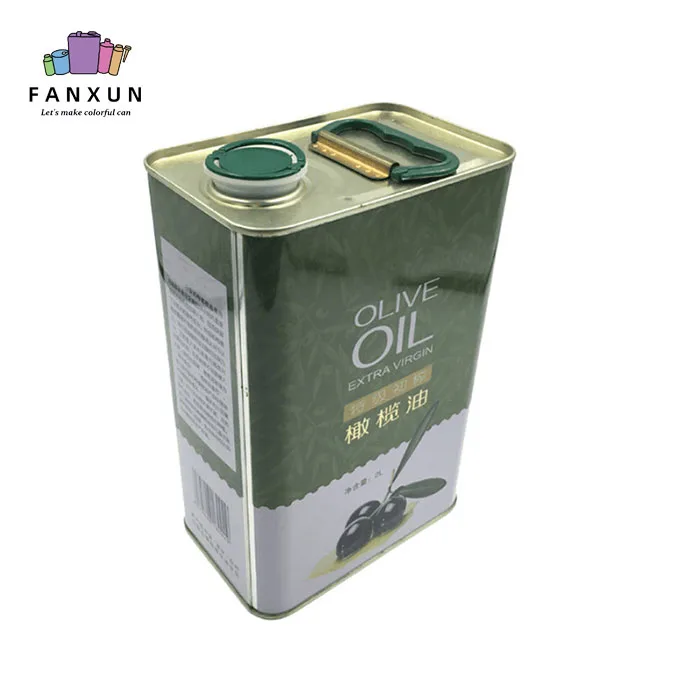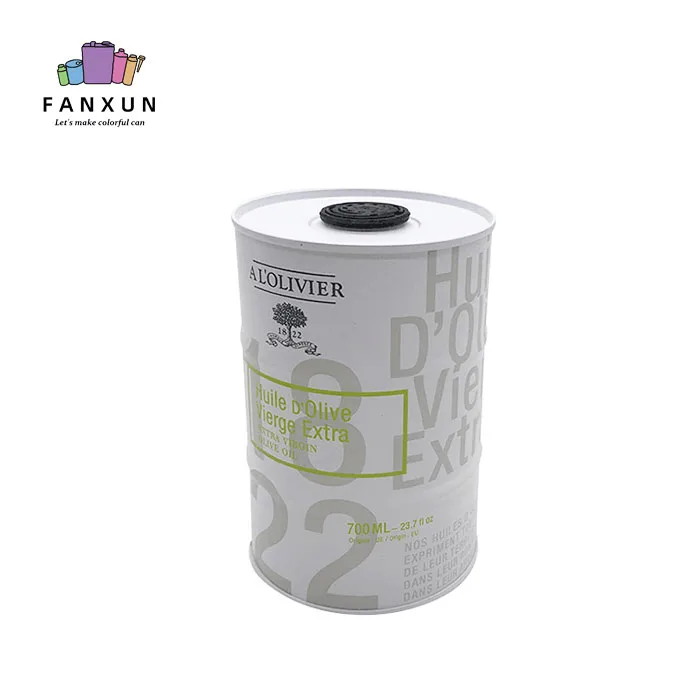The specifications of olive oil containers can be subdivided according to the needs and uses of the product, and you can choose the container specifications that suit you based on the following factors:
Olive oil container capacity
Olive oil container capacities are often available in a variety of sizes to meet different needs and markets. Here are some common olive oil container capacity options:
- Small bottles (small capacity): These bottles usually have a capacity between 250 milliliters (ml) and 500ml, and some are even smaller. The small bottles are suitable for home use and are convenient for consumers to use in cooking or as gifts.
- Medium bottles: Medium-capacity olive oil bottles are usually between 750ml and 1 liter, and are suitable for families and small catering establishments.
- Large cans (large capacity): These bottles usually have a capacity of more than 3 liters and are suitable for restaurants, hotels, food processing plants and other places that require large amounts of olive oil. They often offer affordable options but may be too large for individual home use.
- Canning: Olive oil barrels usually have a capacity of 5 liters, 10 liters, 20 liters or larger. They are mainly used in the catering industry and food production sectors as they can meet large-scale production needs.



Olive oil container uses
Olive oil containers serve a variety of purposes, primarily used to store, protect, and distribute olive oil. Here are some of the main uses for olive oil containers:
- Retail packaging: Olive oil containers are usually used in the retail market for individual consumers to purchase. These containers often come in a variety of capacities and designs, suitable for home cooking and eating. They often come with a convenient pour stopper or sprayer for easy use by customers.
- Catering industry: Restaurants, cafes, bars and hotels usually use olive oil containers to provide olive oil for customers to use. These containers can be small bottles, large bottles or buckets, depending on the size and needs of the restaurant.
- Food production: Food manufacturers use olive oil containers to package their finished food products, such as salad dressings, condiments and cooking oils. These containers usually have large capacities and are used in bulk production.
- Export and distribution: Olive oil containers are used for export and distribution to different countries and regions. They need to comply with international regulations and standards to ensure product quality and safety.
- Gifts and gifts: Exquisite olive oil containers can be used as gifts and gifts. These containers often have attractive packaging and labels, making them suitable for holiday gifting or as a gift to a special customer.
- Storage and preservation: Olive oil containers must be able to effectively store and preserve olive oil to prevent the effects of oxygen and light. They often have airtight properties and an opaque appearance to reduce exposure to oxygen and light.
Overall, olive oil containers are used for a variety of purposes, ranging from home cooking to commercial food production. Choosing the right olive oil container should be determined based on the product’s purpose, target market, and packaging needs.
Olive oil container packaging types:
Olive oil containers are available in a variety of packaging types, each with its own unique features and uses. Here are some common types of olive oil container packaging:
- Glass bottle: Glass bottle is a common type of olive oil packaging, especially suitable for high-quality olive oil. They have a beautiful appearance and can transparently display the color and clarity of olive oil. Glass bottles are usually available in different shapes and capacities, such as square, round, and oval.
- Plastic bottles: Plastic bottles are a lightweight and affordable option for packaging olive oil. They are often used for packaging olive oil in large volumes, such as home packs or for supply in the catering industry. Plastic bottles prevent the breakage issues that glass bottles may face.
- Metal cans: Metal cans (usually iron or stainless steel cans) are another common type of olive oil packaging, especially for large-volume packaging such as catering or industrial use. They provide excellent sealing and freshness retention.
- Ceramic bottle: Ceramic bottle is a traditional and decorative type of olive oil packaging. They are often used in high-end olive oil products or gift packaging.
- Barrel: Barrel olive oil containers are usually used in industry and mass production and have large capacity. They are usually metal or plastic barrels used to store and distribute large quantities of olive oil.
- Bagged: Bagged olive oil is a relatively new type of packaging that usually includes a plastic bag with a built-in spigot, which helps to pour the olive oil easily and keeps the product fresh.
- Canning: Canned olive oil containers are usually used in large-scale industrial production and have large capacities to meet the needs of large-scale production.
- PET bottle: PET (polyethylene terephthalate) bottle is a transparent plastic bottle, usually used to package low-value olive oil, with good transparency and portability.
- Opaque packaging: Opaque packaging materials can be used to reduce the impact of light on olive oil to maintain the freshness and quality of the product.
The choice of olive oil container packaging type should be determined based on the nature, quality, target market and brand image of the product. Different packaging types have different appearances and characteristics and are suitable for different sales occasions and consumer preferences.


Olive oil container quality and freshness
The quality and tightness of your olive oil container are crucial to maintaining the freshness and quality of your olive oil. The following are key factors related to olive oil container quality and preservation:
Material selection:
The material of the container is one of the key factors. Glass bottles, stainless steel jars, and high-quality plastic bottles are often the common materials used for olive oil packaging. These materials will not react adversely with olive oil and have good sealing properties to prevent oxygen and moisture from entering the container.
Sealing performance:
The container must have excellent sealing properties to prevent oxygen and other external factors from entering the container and oxidizing the olive oil. Sealing performance can be achieved through high-quality caps, screw caps or sealing technology.
Opacity:
Olive oil containers should generally be opaque to reduce the impact of light on the olive oil. Light can cause oxidation reactions, causing the quality of your olive oil to deteriorate. Therefore, choosing an opaque container will protect your olive oil from light.
Sealing material:
Container sealing materials, such as lids or rings, should be of high quality and able to effectively maintain a seal. These seals are usually made from food-grade materials to ensure they will not adversely affect the olive oil.
Packaging Cleanliness and Hygiene:
Containers must be kept clean and hygienic during production to prevent microbial contamination and the transfer of odors to the olive oil.
Olive oil container brand image
The brand image of olive oil containers plays an important role in product packaging and marketing. A good brand image can attract consumers’ attention, convey the product’s values and features, and increase product recognition. Here are some key aspects about olive oil container branding:
Package Design
The appearance and design of your container is one of the key elements of your brand image. Packaging should have an attractive appearance that highlights the brand’s logo and identity while conveying the quality and benefits of the product. Packaging design can consider using images and elements about olive trees, Mediterranean style or other olive oil-related images.
logos and logos
Brand logos and logos are a core part of your brand image. They should be clearly visible, easily identifiable, and coordinated with product packaging. Logos and logos can include a brand name, slogan, emblem or other brand-related elements.
Selection of color
Color has a powerful influence in brand image. Choosing colors associated with olive oil, such as green, gold, or dark blue, can help establish your brand’s visual identity.
Packaging material
Packaging materials can reflect the brand’s values. For example, using a high-quality glass bottle may convey the high quality and sophistication of the product, while using environmentally friendly materials may emphasize the sustainability of the brand.
Narrative
Brand image can also be conveyed through storytelling. Sharing stories about the olive oil’s production process, geographical origins or family traditions can increase the emotional connection and appeal of the product.
Social media and online presence
Establishing a brand presence on social media platforms and online channels is also part of the brand identity. By regularly updating content, engaging with customers, and spreading brand messaging, you can enhance the consistency and credibility of your brand image.
Brand reputation
Brand reputation is a key component of brand image. Providing high-quality, reliable and honest products and responding proactively to customer feedback helps build a positive brand reputation.
Packaging innovation
Always pay attention to packaging innovation and seek features and designs that are different from competitors to highlight the brand.
The brand image of your olive oil container should be carefully crafted based on your target market and brand positioning. A strong brand image can help attract customers, increase sales, and build a long-term loyal customer base.
